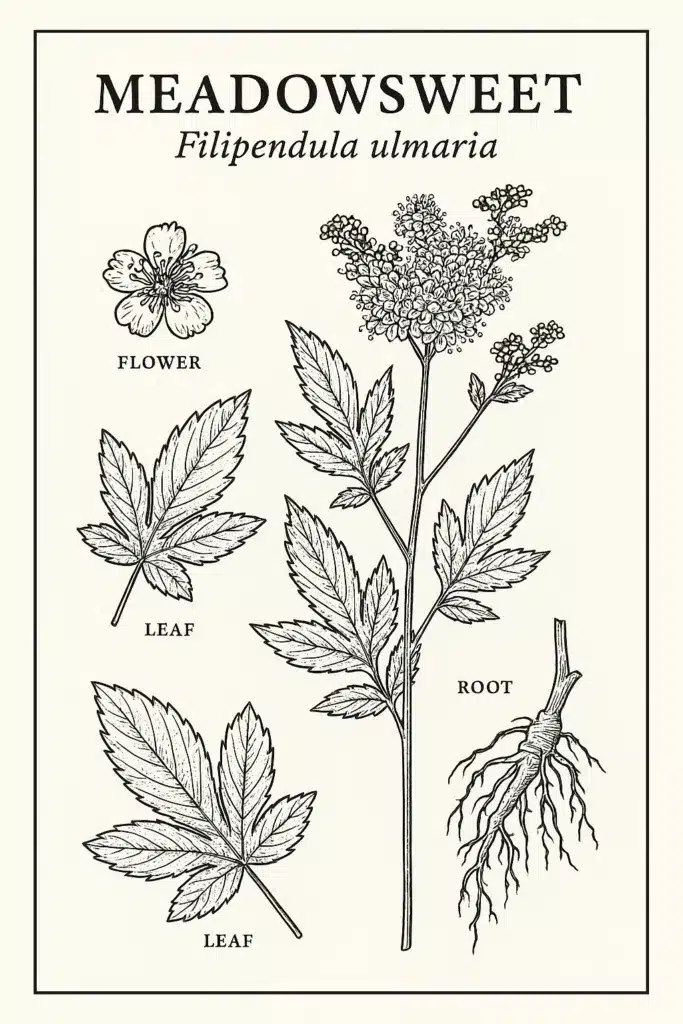Meadowsweet
Filipendula ulmaria — Materia Medica

Snapshot
Studies suggest Meadowsweet’s salicylate and polyphenol content contribute to anti-inflammatory and gastroprotective effects. Traditionally used for pain, fevers, and digestive complaints; modern research supports mild antacid and anti-inflammatory activity.Introduction
Meadowsweet (Filipendula ulmaria) is a perennial herb native to Europe and Asia, celebrated for its fragrant blossoms and historic role in herbal medicine. Known as “Queen of the Meadow,” it has been used for centuries to ease pain, cool fevers, and calm digestive complaints. Modern research supports many of these uses, crediting its salicylates, flavonoids, and tannins with anti-inflammatory and gastroprotective properties.
Botanical Profile
-
Scientific name: Filipendula ulmaria
-
Family: Rosaceae
-
Common names: Meadowsweet, Queen of the Meadow, Meadwort
-
Habitat: Damp meadows, riverbanks, ditches; thrives in temperate Europe and Asia.
-
Description: Grows 1–1.5 m tall; leaves pinnate, serrated, with a downy underside; flowers creamy-white, fragrant, clustered in dense sprays.
Traditional Uses
Meadowsweet was highly valued in medieval Europe and was one of the three most sacred herbs of the Druids (along with water mint and vervain).
-
Folk medicine: used for fevers, joint pain, and diarrhea.
-
Culinary: flowers added to mead, beer, and vinegars for flavor.
-
Historic recognition: credited as one of the plants that inspired the discovery of aspirin, due to its salicylic acid derivatives.
Constituents & Actions
Key phytochemicals:
-
Salicylates (methyl salicylate, salicin) → mild analgesic, antipyretic, anti-inflammatory.
-
Tannins → astringent, protective to gut lining.
-
Flavonoids (quercetin, rutin, spiraeoside) → antioxidant, vascular support.
-
Volatile oils → fragrance, mild antimicrobial.
Primary actions: anti-inflammatory, analgesic (anodyne), antacid, astringent, diaphoretic, carminative.
Herbal Benefits
Fever and Colds
Traditionally brewed as a tea for feverish conditions, meadowsweet supports cooling and perspiration.
Joint Pain & Inflammation
The salicylates provide mild relief for rheumatism, arthritis, and musculoskeletal pain.
Digestive Health
The tannins and mucilage calm irritation, while salicylates reduce inflammation. Used for gastritis, ulcers, heartburn, and diarrhea.
Cardiovascular Support
Flavonoids offer vascular protection; historically used as a “blood cleanser.”
Skin Uses
Topically, infusions or ointments may ease inflammatory skin conditions.
Preparations & Dosage
-
Tea (infusion): 1–2 tsp dried flowering tops per cup of hot water, steep 10–15 min, up to 3x daily.
-
Tincture: 2–4 mL (1:5, 25% ethanol) up to 3x daily.
-
Decoction (root): simmer gently for 10–15 min for digestive support.
-
Capsules/Powder: standardized extracts available in some markets.
Modern Research
Emerging studies highlight meadowsweet’s dual action: salicylates for pain/inflammation relief, and polyphenols with protective effects on the gastric lining — unlike aspirin, which may irritate the stomach. In vitro studies show antioxidant and antimicrobial effects, though more human clinical trials are needed.
Safety & Contraindications
-
Avoid if allergic to aspirin or salicylates.
-
Do not give to children with viral infections (Reye’s syndrome risk).
-
Use caution with anticoagulants, antiplatelet medications, or NSAIDs.
-
Generally safe in moderate traditional doses (tea, tincture).
Identification & Harvest Notes
Meadowsweet is easily identified by its tall stems, serrated leaves, and clouds of creamy flowers with a sweet almond-like fragrance. Harvest flowering tops in midsummer when blooms are abundant. Roots can be dug in autumn for decoction.
Related Herbs
-
Willow bark (Salix alba): another natural source of salicylates.
-
Yarrow (Achillea millefolium): cooling, fever support.
-
White willow vs meadowsweet: comparison for pain relief and gastric safety.
Internal Links
References
-
Tomas-Barberan FA, et al. “Phytochemistry of Filipendula ulmaria.” Fitoterapia, 2015. doi:10.1016/j.fitote.2015.03.001
-
Kivimaki AS, et al. “Polyphenols of meadowsweet: anti-inflammatory and gastroprotective activity.” Phytochemistry, 2019. doi:10.1016/j.phytochem.2019.112256
Identification & Harvest
Erect perennial up to 1.5 m tall, with clusters of creamy-white fragrant flowers; prefers damp meadows and riverbanks. Harvest flowering tops in mid-summer.Preparations
- tea-infusion
- decoction
- tincture
- syrup
- capsule
Safety
Avoid with aspirin sensitivity, salicylate allergy, or in children with viral infections (Reye’s syndrome risk). Caution with anticoagulant/antiplatelet drugs. Generally safe in moderate doses as tea or tincture.Related Research
No studies yet.
References
- (2015) Meadowsweet (Filipendula ulmaria) in European traditional medicine: phytochemistry and pharmacology.
- (2019) Anti-inflammatory activity of meadowsweet polyphenols
Educational content only; not medical advice.
